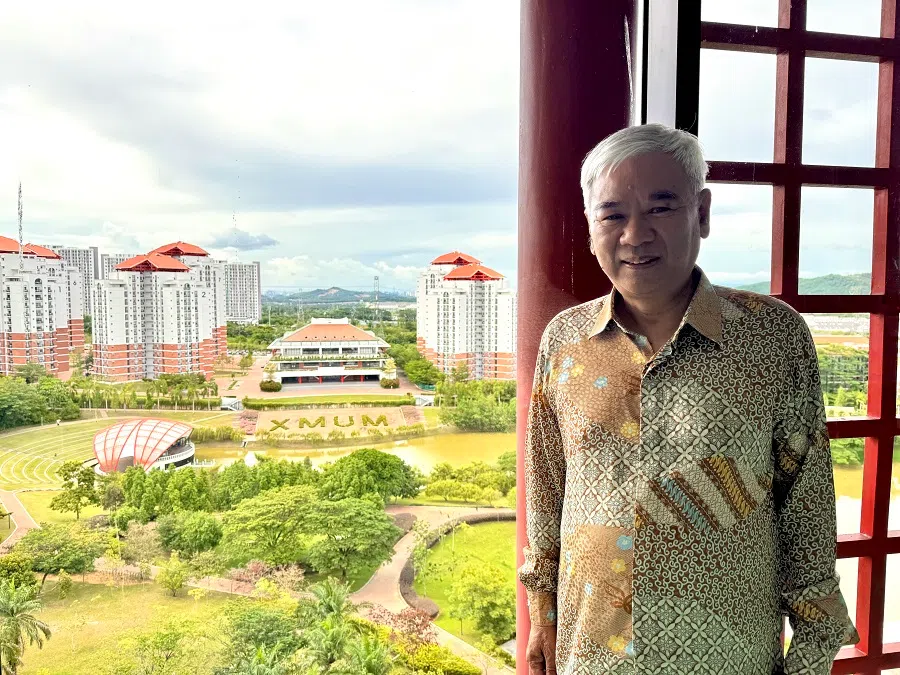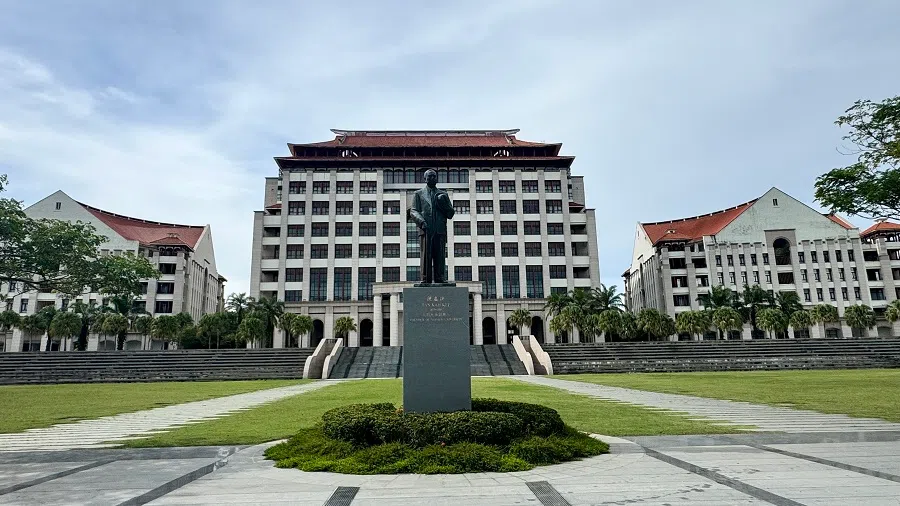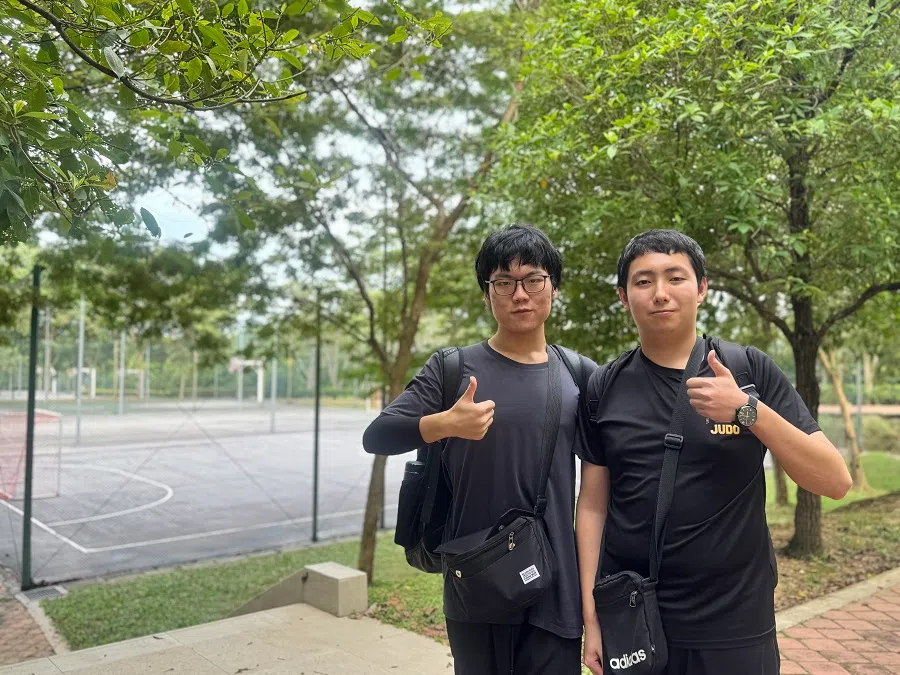[Big read] Why Chinese students are flocking to Malaysia

Given Malaysia’s close cultural connection to China and its multilingual and multicultural education environment, Chinese students are increasingly choosing Malaysia to further their studies. Lianhe Zaobao correspondent Seoow Juin Yee finds out the benefits and downsides of this trend.
(Photos: Seoow Juin Yee/SPH Media)
Over a century ago, Tan Kah Kee, a prominent Chinese-born philanthropist from the Nanyang region, used the wealth he amassed from the Malay peninsula to set up Xiamen University in his hometown of Fujian, nurturing talented individuals. Ninety-three years later, Xiamen University established a branch campus in Malaysia to give back to the local community — a “historic reciprocation”, in the words of former Xiamen University president Zhu Chongshi.
Xiamen University Malaysia (XMUM) is located in Sepang, approximately 45 kilometres south of Kuala Lumpur and near the Kuala Lumpur International Airport. The XMUM campus design clearly pays homage to the main Xiamen University campus.
Historical and emotional ties with Nanyang
Entering through the south gate, one is greeted by a cluster of Tan Kah Kee-style architecture that blends white-walled Western buildings with Chinese red roofs. The main building is flanked by four teaching blocks, echoing the iconic “one main, four auxiliary” arrangement of the Jian’nan complex in Xiamen University. Like in Xiamen University, Furong Lake is the centrepiece of the XMUM campus. From attending classes and living in dormitories to participating in campus activities, everything revolves around the lake.
Professor Wang Ruifang, president of XMUM, told Lianhe Zaobao that Xiamen University shares deep historical and emotional ties with Nanyang. The university viewed the Malaysian government’s invitation to establish a branch campus not only as a responsibility but also as a valuable opportunity.
“Xiamen University was founded by overseas Chinese philanthropist Tan Kah Kee in 1921. Returning to Malaysia is paying tribute to its founder and a way to give back to the land and people who supported him, carrying forward the Tan Kah Kee spirit,” he said.
Malaysia’s geographical advantage, coupled with its relatively low cost of living, stable social environment and sound legal system, are important factors in Xiamen University’s decision to establish its overseas branch campus there.

Chinese President Xi Jinping’s proposal of the 21st Century Maritime Silk Road in 2013 provided significant impetus for Xiamen University to expand beyond China.
Wang said that China needs talents with global perspectives and an understanding of diverse cultures. XMUM also aims to cultivate more high-quality talent for countries along the Belt and Road Initiative.
At the same time, setting up an overseas branch is an important step in Xiamen University’s internationalisation efforts. “Among China’s numerous tertiary institutions, Xiamen University is the first to set up an overseas branch, which we believe to be a truly invaluable opportunity,” he noted.
Malaysia’s geographical advantage, coupled with its relatively low cost of living, stable social environment and sound legal system, are important factors in Xiamen University’s decision to establish its overseas branch campus there.

Wang pointed out that there are roughly 7.4 million ethnic Chinese in Malaysia, which boasts the most complete preservation of Chinese culture outside of mainland China, Hong Kong, Macau and Taiwan. “This substantial Chinese community not only serves as a crucial base of popular support but also acts as a significant bridge attracting Chinese students to study in Malaysia,” he said.
Furthermore, Malaysia’s predominantly Muslim population provides Xiamen University with an advantageous foundation to reach a potential student base of over a billion people across Central Asia, South Asia and the Muslim world.
... courses at XMUM are taught in English except Chinese Studies and Traditional Chinese Medicine, which are taught in both Chinese and English.
Study in English, recognised in Malaysia and China
Unlike Xiamen University’s educational model in China, courses at XMUM are taught in English except Chinese Studies and Traditional Chinese Medicine, which are taught in both Chinese and English.
Wang said that the branch campus’s multicultural and multilingual environment is deeply appealing to Chinese-funded enterprises and multinational corporations. “The use of English as the medium of instruction as well as our multicultural background not only allows students to interact with Chinese enterprises but also to gain a deep understanding of the business landscape in Malaysia and Southeast Asia as a whole,” he noted.
XMUM is steadily gaining recognition from Malaysian parents and students in recent years. When the branch campus was first established, local students primarily came from Chinese independent high schools. However, a growing number of graduates from government secondary schools have been applying for admission using their Malaysian Certificate of Education (SPM) results, indicating an increasing acceptance of XMUM among local students.

Malaysian student Zheng Minxiang said in an interview that he chose to study at XMUM because of its English-medium education system and the fact that the degree awarded by Xiamen University is recognised by both Malaysia and China, which gave him more confidence.
Zheng Zehang, 19, a second-year computer science student from China’s Henan, said that English-medium education is both a challenge and an advantage. “Compared with classmates accustomed to Chinese-medium instruction, we can adapt to the international workplace sooner, which is beneficial for future employment,” he said.
Today, XMUM boasts a cohort of over 9,000 students, of which about 5,000 are local and some 2,500 are from China. The remainder comes from 48 other countries...
Support from Malaysian government and local Chinese community
When Xiamen University was planning for its branch campus in Malaysia, it faced a variety of options for its educational model. Ultimately, Xiamen University’s leadership team decided to solely fund the construction of an independent campus to create a multi-disciplinary, multi-level institute of higher learning. It also gained the support of the Malaysian government and the local Chinese community.
Today, XMUM boasts a cohort of over 9,000 students, of which about 5,000 are local and some 2,500 are from China. The remainder comes from 48 other countries, with the teaching faculty hailing from 26 countries, showcasing its international and diverse characteristics.
Wang felt that Xiamen University brought China’s excellent educational concepts and resources to Malaysia, successfully integrating with the policy framework, cultural background and market demand. He added, “This gives our educational model a unique character, and the students we cultivate have a competitive edge from a diverse environment.”
As China and Malaysia continue to deepen their cooperation in the education sector, Xiamen University’s experience in running a campus abroad serves as a reference for other Chinese higher education institutions seeking to expand internationally.
Wang stated, “We have somewhat taken on a pioneering and experimental role. Although our experience may not be directly replicable, it does provide insights and reflections for those who come after us.”
China’s education market beckons
XMUM is the first overseas branch of a Chinese university and has produced over 6,000 graduates since enrollment started in February 2016. The successful experience prompted China and Malaysia to strengthen their cooperation in higher education.
Malaysia’s top institution, Universiti Malaya (UM), would set up a branch in Shandong, China. UM is set to become the first Malaysian public university to establish a branch campus in China.

Last year, the Malaysian government invited Tsinghua University, ranked first in Asia, to establish a branch campus, while Malaysia’s top institution, Universiti Malaya (UM), would set up a branch in Shandong, China. UM is set to become the first Malaysian public university to establish a branch campus in China.
When announcing the news in early April, UM’s vice chancellor Noor Azuan Abu Osman said that establishing a branch campus in China would help the university better leverage China’s economic and technological strengths. The overseas campus is slated to open next year.
UM is also working with Peking University to prepare a foundational programme, and will set up service centres in Beijing and Kuala Lumpur to assist Chinese students.
China’s education market holds enormous potential, and many Malaysian private higher education institutions have already long been collaborating with Chinese universities and vocational colleges. Malaysia’s INTI International University is one such school; Chinese students enroll to study English, and they continue with other courses after passing English proficiency tests.
Malaysia is gradually becoming one of the top destinations for Chinese students studying abroad, as well as a foothold for Chinese educational corporations to expand overseas.

INTI’s founder, Tan Yew Sing, told Lianhe Zaobao that the institution started recruiting in China as early as 1995, and began collaborating with local higher education institutions. For instance, INTI and the Beijing University of Chinese Medicine jointly offer a Traditional Chinese Medicine programme, allowing students to study in Malaysia for three years and then finish the remaining two years in China.
In addition to offering dual-degree programmes, several Malaysian private higher education institutions, such as Taylor’s University and Lincoln University College, have proactively engaged in joint education, student exchanges and research collaborations with Chinese universities. Moreover, Malaysia University of Science and Technology has been certified by China’s Ministry of Education as a Belt and Road partner university, engaging in deep collaborations with Chinese institutions in engineering, business as well as other fields.
In recent years, Chinese private education corporations have also entered Malaysia’s education market, expanding their overseas education footprint through acquiring higher education institutions. According to Chinese media reports, China’s TPG Capital acquired a controlling stake in Malaysia’s Asia Pacific University of Technology & Innovation through its subsidiary The Rise Fund, while Shandong’s Weifang Institute of Technology acquired a 70% stake in Nilai University.
Malaysia is gradually becoming one of the top destinations for Chinese students studying abroad, as well as a foothold for Chinese educational corporations to expand overseas.
“This trend is changing. The number of local students going to mainland China has gradually increased since 2016 and even surpassed those going to Taiwan in 2018.” — Tan Yew Sing, Chair, United Chinese School Committees’ Association of Malaysia and Merdeka Education Centre
More Malaysian students choosing China over Taiwan
Although Europe and the US remain the preferred destinations for Malaysian students studying abroad, more Malaysian students are choosing to study in China given its rapid development in various academic and technological fields.
Tan Yew Sing, chair of the United Chinese School Committees’ Association of Malaysia as well as Merdeka Education Centre, said that in the past most graduates from Chinese independent high schools in Malaysia chose to further their studies in Taiwan, with numbers ranging from 800 to 1,500 annually, while relatively fewer went to mainland China, numbering less than 200 between 2010 and 2015.
Tan added, “This trend is changing. The number of local students going to mainland China has gradually increased since 2016 and even surpassed those going to Taiwan in 2018.”

He believes that China’s development in hi-tech fields such as new energy, artificial intelligence and 5G technology has caught the eye of more Malaysian students, and the number of students choosing to further their studies in China is expected to continue increasing.
Wang also pointed out that the steady development of China’s economy and technology has enhanced the confidence of parents and students in China’s higher education. Moreover, the increase in scholarship opportunities at Chinese universities in recent years has become one important factor attracting Malaysian students.
“Amid the current international climate, Chinese institutes of higher learning are allocating more international recruitment resources to Southeast Asia, particularly targeting Malaysian students with a strong foundation in the Chinese language, ” Wang said.
In addition to academic disciplines, China and Malaysia are also strengthening cooperation in vocational education and training. Last year, the Chinese government pledged to offer 5,000 training slots to Malaysia, providing Malaysian youths the opportunity to learn from 220 Chinese enterprises or vocational education centres.
Integration difficult for Chinese students
In recent years, an increasing number of Chinese students have chosen to pursue their studies in Southeast Asian countries. This trend is not only driven by intense pressure surrounding higher education and employment in China but also reflecting the growing financial capabilities of families in second- and third-tier cities, enabling them to support their children’s overseas education.
Tensions between China and Western countries have also led some Chinese students to opt for Southeast Asia as a study destination. Among these countries, Malaysia has emerged as a top choice due to its cultural similarities with China, lower cost of living and improving quality of education.
Tan Yew Sing said that in recent years, the number of Chinese students studying in Malaysia has grown significantly. He explained, “INTI enrolled about 2,500 Chinese students last year, a third of whom were postgraduate students. This year, enrollment is expected to increase to 3,000.”
... some Chinese students studying in Malaysia tend to form cliques due to language barriers and different upbringings, and also interact less with students of other nationalities. — Tan

Official data show that as of last year, Malaysia hosted 57,000 Chinese international students, while nearly 20,000 Malaysian students were studying in China. With deepening bilateral cooperation in education, these numbers are expected to continue rising.
However, Tan observed that there are notable differences in language proficiency and cultural adaptation between Malaysian and Chinese students. Malaysian students generally adapt more easily and integrate well into the learning environment in China. In contrast, some Chinese students studying in Malaysia tend to form cliques due to language barriers and different upbringings, and also interact less with students of other nationalities.
He acknowledged that this poses certain challenges for higher education institutions in Malaysia in terms of resource allocation. “Universities often need to invest more resources to help Chinese students better adapt to the local academic and living environment,” Tan remarked.
Profit over education?
As educational cooperation between Malaysia and China grows closer, scholars have cautioned against letting such partnerships stagnate, emphasising the importance of maintaining education quality and ensuring sustainable development.
A Malaysian university academic who declined to be named said in an interview that current education cooperation between Malaysia and China lacks long-term planning and is often driven by political performance and public relations, leading to collaborations for the sake of it.
“If this continues, it may not be beneficial for either side and could even have adverse effects,” the academic said.
A recent buzzword circulating on Chinese social media, “shuibo” (水博, meaning watered-down academic qualifications), questions the academic credibility of some doctoral degrees from Southeast Asian universities.
He noted that competition among private universities in Malaysia is intense, and with the growth in domestic student enrollment slowing, many institutions now view Chinese international students as a key source of income, shifting the focus of education towards profit.
A recent buzzword circulating on Chinese social media, “shuibo” (水博, meaning watered-down academic qualifications), questions the academic credibility of some doctoral degrees from Southeast Asian universities. The academic said, “Malaysia hasn’t reached the point of being discredited yet, but if standards are not strictly upheld, it may eventually get there.”
Meanwhile, with the rapid increase in the number of Chinese international students, some higher education institutions in Malaysia are facing limited resource allocation, which in turn affects the quality of teaching and student services.

The US, as a global hub for higher education, has thousands of institutes of higher learning and enrolls over a million international students. “In contrast, Malaysia has fewer than 40 institutions genuinely capable of accommodating international students, yet we are hosting nearly 60,000 Chinese students,” the academic said.
He added that many Chinese students have a limited understanding of Malaysia’s higher education system and are often unprepared for overseas study. At the same time, some Malaysian universities are ill-equipped to handle the influx of Chinese students.
Moreover, the vast majority of Chinese graduates return to China after completing their studies, with very few staying in Malaysia to work. This has led some to question the effectiveness of these educational exchanges.
Some analysts believe that educational cooperation should not focus solely on numbers but rather on actual needs. Malaysia should also remain rational when introducing foreign universities into the country — an excessive pursuit of overseas brand-name institutions may result in the neglect of long-term development of its own higher education system and academic foundations.
This article was first published in Lianhe Zaobao as “厦大回馈历史情 马中深化留学谊”.



![[Big read] China’s 10 trillion RMB debt clean-up falls short](https://cassette.sphdigital.com.sg/image/thinkchina/d08cfc72b13782693c25f2fcbf886fa7673723efca260881e7086211b082e66c)

